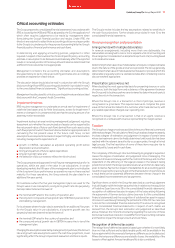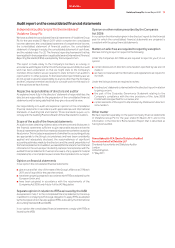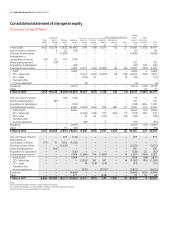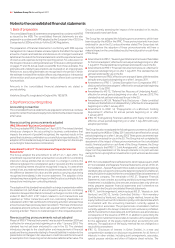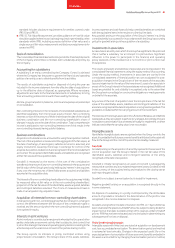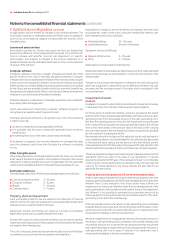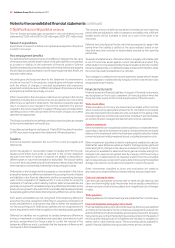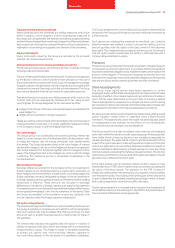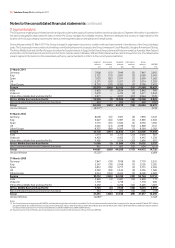Vodafone 2011 Annual Report Download - page 87
Download and view the complete annual report
Please find page 87 of the 2011 Vodafone annual report below. You can navigate through the pages in the report by either clicking on the pages listed below, or by using the keyword search tool below to find specific information within the annual report.
Vodafone Group Plc Annual Report 2011 85
Financials
income, expenses and cash flows of jointly controlled entities are combined
with the equivalent items in the results on a line-by-line basis.
Any goodwill arising on the acquisition of the Group’s interest in a jointly
controlled entity is accounted for in accordance with the Group’s accounting
policy for goodwill arising on the acquisition of a subsidiary.
Investments in associates
An associate is an entity over which the Group has significant influence and
that is neither a subsidiary nor an interest in a joint venture. Significant
influence is the power to participate in the financial and operating
policy decisions of the investee but is not control or joint control over
those policies.
The results and assets and liabilities of associates are incorporated in the
consolidated financial statements using the equity method of accounting.
Under the equity method, investments in associates are carried in the
consolidated statement of financial position at cost as adjusted for post-
acquisition changes in the Group’s share of the net assets of the associate,
less any impairment in the value of the investment. Losses of an associate in
excess of the Group’s interest in that associate are not recognised. Additional
losses are provided for, and a liability is recognised, only to the extent that
the Group has incurred legal or constructive obligations or made payments
on behalf of the associate.
Any excess of the cost of acquisition over the Group’s share of the net fair
value of the identifiable assets, liabilities and contingent liabilities of the
associate recognised at the date of acquisition is recognised as goodwill. The
goodwill is included within the carrying amount of the investment.
The licences of the Group’s associate in the US, Verizon Wireless, are indefinite
lived assets as they are subject to perfunctory renewal. Accordingly, they are
not subject to amortisation but are tested annually for impairment, or when
indicators exist that the carrying value is not recoverable.
Intangible assets
Identifiable intangible assets are recognised when the Group controls the
asset, it is probable that future economic benefits attributed to the asset will
flow to the Group and the cost of the asset can be reliably measured.
Goodwill
Goodwill arising on the acquisition of an entity represents the excess of the
cost of acquisition over the Group’s interest in the net fair value of the
identifiable assets, liabilities and contingent liabilities of the entity
recognised at the date of acquisition.
Goodwill is initially recognised as an asset at cost and is subsequently
measured at cost less any accumulated impairment losses. Goodwill is held
in the currency of the acquired entity and revalued to the closing rate at
each reporting period date.
Goodwill is not subject to amortisation but is tested for impairment.
Negative goodwill arising on an acquisition is recognised directly in the
income statement.
On disposal of a subsidiary or a jointly controlled entity, the attributable
amount of goodwill is included in the determination of the profit or loss
recognised in the income statement on disposal.
Goodwill arising before the date of transition to IFRS, on 1 April 2004, has
been retained at the previous UK GAAP amounts, subject to being tested for
impairment at that date. Goodwill written off to reserves under UK GAAP
prior to 1998 has not been reinstated and is not included in determining any
subsequent profit or loss on disposal.
Finite lived intangible assets
Intangible assets with finite lives are stated at acquisition or development
cost, less accumulated amortisation. The amortisation period and method
is reviewed at least annually. Changes in the expected useful life or the
expected pattern of consumption of future economic benefits embodied in
the asset is accounted for by changing the amortisation period or method,
standard includes disclosure requirements for entities covered under
IFRS 10 and IFRS 11.
■IFRS 13, ‘Fair Value Measurement’, provides guidance on how fair value
should be applied where its use is already required or permitted by other
standards within IFRS, including a precise definition of fair value and a
single source of fair value measurement and disclosure requirements for
use across IFRS.
Basis of consolidation
The consolidated financial statements incorporate the financial statements
of the Company and entities controlled, both unilaterally and jointly, by
the Company.
Accounting for subsidiaries
A subsidiary is an entity controlled by the Company. Control is achieved
where the Company has the power to govern the financial and operating
policies of an entity so as to obtain benefits from its activities.
The results of subsidiaries acquired or disposed of during the year are
included in the income statement from the effective date of acquisition or
up to the effective date of disposal, as appropriate. Where necessary,
adjustments are made to the financial statements of subsidiaries to bring
their accounting policies into line with those used by the Group.
All intra-group transactions, balances, income and expenses are eliminated
on consolidation.
Non-controlling interests in the net assets of consolidated subsidiaries are
identified separately from the Group’s equity therein. Non-controlling
interests consist of the amount of those interests at the date of the original
business combination and the non-controlling shareholder’s share of
changes in equity since the date of the combination. Total comprehensive
income is attributed to non-controlling interests even if this results in the
non-controlling interests having a deficit balance.
Business combinations
Acquisitions of subsidiaries are accounted for using the acquisition method.
The cost of the acquisition is measured at the aggregate of the fair values, at
the date of exchange, of assets given, liabilities incurred or assumed, and
equity instruments issued by the Group in exchange for control of the
acquiree. Acquisition-related costs are recognised in the income statement
as incurred. The acquiree’s identifiable assets and liabilities are recognised
at their fair values at the acquisition date.
Goodwill is measured as the excess of the sum of the consideration
transferred, the amount of any non-controlling interests in the acquiree and
the fair value of the Group’s previously held equity interest in the acquiree,
if any, over the net amounts of identifiable assets acquired and liabilities
assumed at the acquisition date.
The interest of the non-controlling shareholders in the acquiree may initially
be measured either at fair value or at the non-controlling shareholders’
proportion of the net fair value of the identifiable assets acquired, liabilities
and contingent liabilities assumed. The choice of measurement basis is
made on an acquisition-by-acquisition basis.
Acquisition of interests from non-controlling shareholders
In transactions with non-controlling parties that do not result in a change in
control, the difference between the fair value of the consideration paid or
received and the amount by which the non-controlling interest is adjusted
is recognised in equity.
Interests in joint ventures
A joint venture is a contractual arrangement whereby the Group and other
parties undertake an economic activity that is subject to joint control; that
is, when the strategic financial and operating policy decisions relating to the
activities require the unanimous consent of the parties sharing control.
The Group reports its interests in jointly controlled entities using
proportionate consolidation. The Group’s share of the assets, liabilities,




